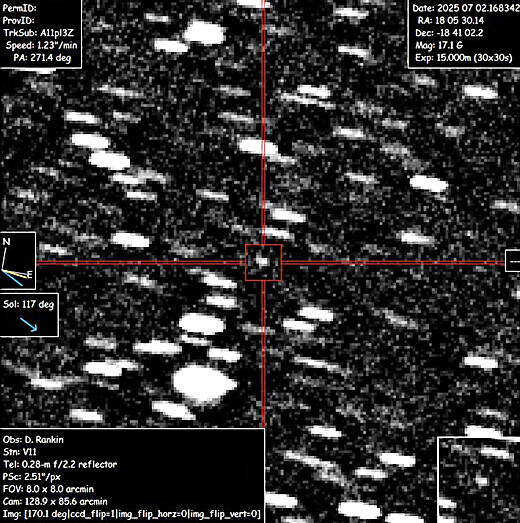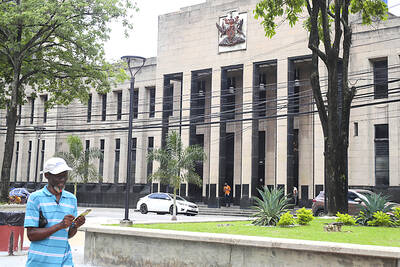Astronomers on Wednesday confirmed the discovery of an interstellar object racing through the solar system — only the third-ever spotted, although scientists suspect many more might slip past unnoticed.
The visitor from the stars, designated 3I/Atlas, is likely the largest yet detected, and has been classified as a comet, or cosmic snowball.
“It looks kind of fuzzy,” said Peter Veres, an astronomer with the International Astronomical Union’s Minor Planet Center, which was responsible for the official confirmation. “It seems that there is some gas around it, and I think one or two telescopes reported a very short tail.”

Photo: David Rankin, Saguaro Observatory via AFP
Originally known as A11pl3Z before it was confirmed to be of interstellar origin, the object poses no threat to Earth, said Richard Moissl, head of planetary defense at the European Space Agency.
“It will fly deep through the solar system, passing just inside the orbit of Mars,” but will not hit our neighboring planet, he said.
Excited astronomers are still refining their calculations, but the object appears to be zooming more than 60 kilometers per second. That would mean it is not bound by the sun’s orbit, unlike objects that remain within the solar system.
Its trajectory also “means it’s not orbiting our star, but coming from interstellar space and flying off to there again,” Moissl said.
“We think that probably these little ice balls get formed associated with star systems,” added Jonathan McDowell, an astronomer at the Harvard-Smithsonian Center for Astrophysics. “And then as another star passes by, tugs on the ice ball, frees it out. It goes rogue, wanders through the galaxy, and now this one is just passing us.”
A Chile based observatory that is part of the NASA-funded ATLAS survey first discovered the object on Tuesday.
Professional and amateur astronomers across the world then searched through past telescope data, tracing its trajectory back to at least June 14.
The object is estimated to be about 10km to 20km wide, Moissl said, which would make it the largest interstellar interloper ever detected.
However, the object could be smaller if it is made out of ice, which reflects more light.
Veres said the object would continue to brighten as it nears the sun, bending slightly under the pull of gravity, and is expected to reach its closest point — perihelion — on Oct. 29.
It would then recede and exit the solar system over the next few years.
It marks only the third time humanity has detected an object entering the solar system from the stars.
The first, ‘Oumuamua, was discovered in 2017. It was so strange that at least one prominent scientist became convinced it was an alien vessel — although that has since been contradicted by further research.
The second interstellar visitor, 2I/Borisov, was spotted in 2019.
There is no reason to suspect an artificial origin for 3I/Atlas, but teams around the world are racing to answer key questions about things such as its shape, composition and rotation.
Mark Norris, an astronomer at the UK’s University of Central Lancashire, said that the new object appears to be “moving considerably faster than the other two extrasolar objects that we previously discovered.”
The object is currently roughly about the distance from Jupiter away from Earth, Norris said.
He said that modeling estimated that there could be as many as 10,000 interstellar objects drifting through the solar system at any given time, although most would be smaller than the newly discovered object.
The visitors offer scientists a rare chance to study something outside of our solar system.
For example, should researchers detect the precursors of life such as amino acids on such an object, it would give them “a lot more confidence that the conditions for life exist in other star systems,” Norris said.

IDENTITY: A sex extortion scandal involving Thai monks has deeply shaken public trust in the clergy, with 11 monks implicated in financial misconduct Reverence for the saffron-robed Buddhist monkhood is deeply woven into Thai society, but a sex extortion scandal has besmirched the clergy and left the devout questioning their faith. Thai police this week arrested a woman accused of bedding at least 11 monks in breach of their vows of celibacy, before blackmailing them with thousands of secretly taken photos of their trysts. The monks are said to have paid nearly US$12 million, funneled out of their monasteries, funded by donations from laypeople hoping to increase their merit and prospects for reincarnation. The scandal provoked outrage over hypocrisy in the monkhood, concern that their status

Trinidad and Tobago declared a new state of emergency on Friday after authorities accused a criminal network operating in prisons across the country of plotting to kill key government officials and attack public institutions. It is the second state of emergency to be declared in the twin-island republic in a matter of months. In December last year, authorities took similar action, citing concerns about gang violence. That state of emergency lasted until mid-April. Police said that smuggled cellphones enabled those involved in the plot to exchange encrypted messages. Months of intelligence gathering led investigators to believe the targets included senior police officers,

The United States Federal Communications Commission said on Wednesday it plans to adopt rules to bar companies from connecting undersea submarine communication cables to the US that include Chinese technology or equipment. “We have seen submarine cable infrastructure threatened in recent years by foreign adversaries, like China,” FCC Chair Brendan Carr said in a statement. “We are therefore taking action here to guard our submarine cables against foreign adversary ownership, and access as well as cyber and physical threats.” The United States has for years expressed concerns about China’s role in handling network traffic and the potential for espionage. The U.S. has

A disillusioned Japanese electorate feeling the economic pinch goes to the polls today, as a right-wing party promoting a “Japanese first” agenda gains popularity, with fears over foreigners becoming a major election issue. Birthed on YouTube during the COVID-19 pandemic, spreading conspiracy theories about vaccinations and a cabal of global elites, the Sanseito Party has widened its appeal ahead of today’s upper house vote — railing against immigration and dragging rhetoric that was once confined to Japan’s political fringes into the mainstream. Polls show the party might only secure 10 to 15 of the 125 seats up for grabs, but it is